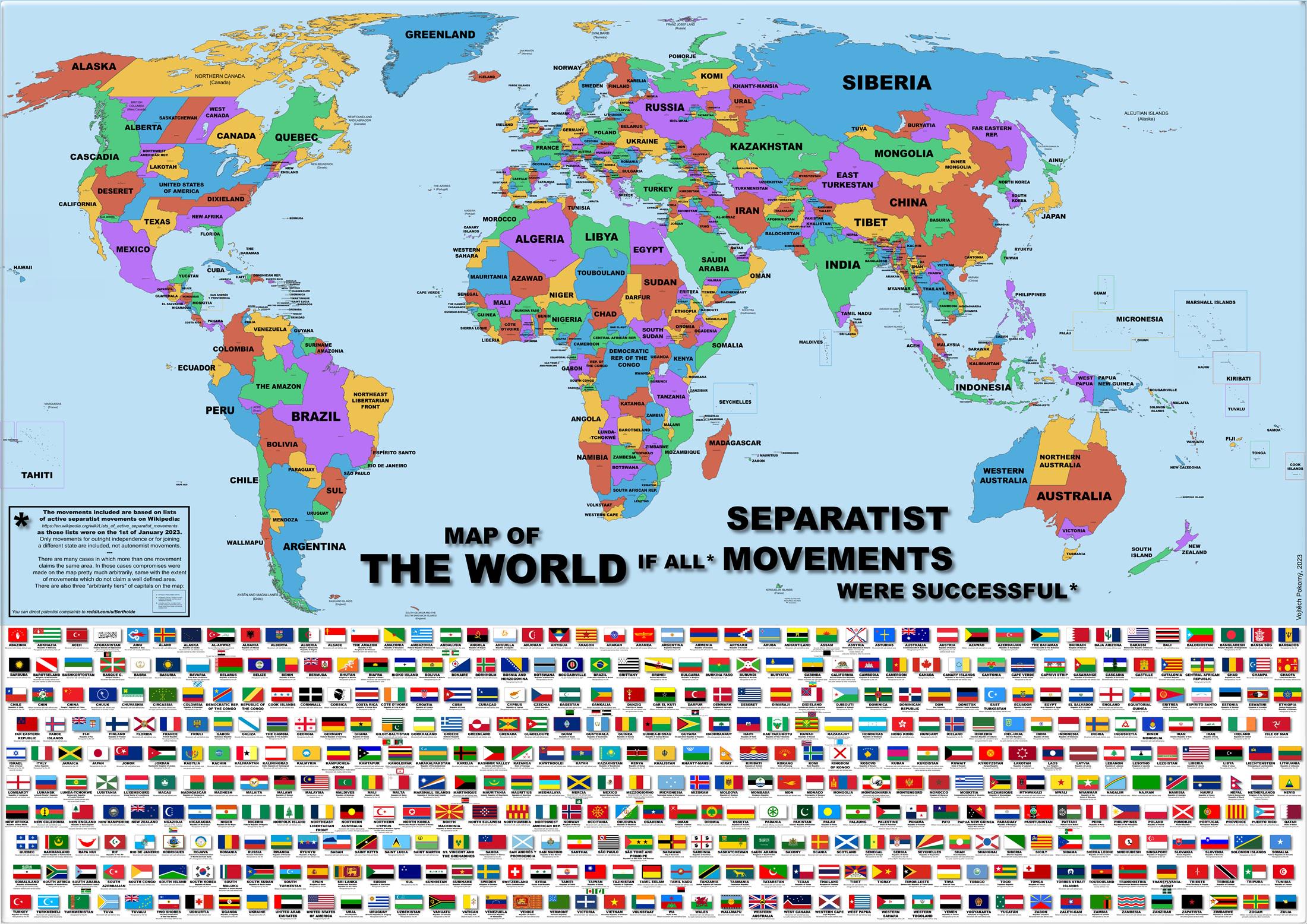Map of the World if All Separatist Movements Succeeded


Alex Cartwright
Senior Cartographer & GIS Specialist
Alex Cartwright is a renowned cartographer and geographic information systems specialist with over 15 years of experience in spatial analysis and data...
Geographic Analysis
What This Map Shows
This map visualizes a hypothetical scenario where all separatist movements around the globe have achieved their goals and established independent nations. It presents a world reshaped by national borders that reflect the aspirations of various ethnic, cultural, and political groups. The visual representation provides insights into how the geopolitical landscape might look if regions like Catalonia, Scotland, and Quebec, among others, became independent states. This thought-provoking map prompts us to consider the complexities of national identity and the ongoing struggle for self-determination.
Deep Dive into Separatist Movements
Separatist movements have been a significant aspect of global politics for centuries, often driven by a desire for greater autonomy, cultural recognition, or independence from larger state entities. These movements arise from diverse factors, including historical grievances, ethnic tensions, political marginalization, and economic disparities. Interestingly, the success of these movements can lead to both positive outcomes, such as increased self-governance and cultural preservation, and negative consequences, including conflict and instability.
In recent years, we've seen several high-profile separatist movements garnering international attention. For instance, in Spain, Catalonia has been at the forefront of the independence debate, with a strong push for a referendum to separate from Spain. Similarly, Scotland's quest for independence has gained momentum, particularly after the Brexit vote, as many Scots felt their interests were overlooked in the broader UK context. These movements are often fueled by a sense of national identity that is distinct from the dominant culture surrounding them.
In Africa, we find movements like the Biafran secession in Nigeria, which highlights the ethnic and economic disparities that have historically plagued the region. The drive for independence in places like South Sudan exemplifies how separatist movements can arise from long-standing conflicts and aspirations for self-determination.
What's fascinating is the diversity in the motivations behind these movements. While some, like the Kurdish independence movement, are rooted in ethnic nationalism, others, such as the Basque separatist movement in Spain, intertwine language, culture, and regional economic interests. Despite the differences, the common thread among these movements is the quest for recognition and the right to govern one's own affairs.
Regional Analysis
When analyzing the map of this hypothetical world, it becomes clear that different regions are affected by separatist movements in varying degrees. In Europe, for instance, the emergence of new nations from existing states could lead to a significantly fragmented political landscape. Catalonia and Scotland would join the ranks of other European nations, each bringing their unique cultures and traditions into the global arena.
In contrast, regions like Southeast Asia might experience a more complex outcome. The independence aspirations of groups in places like West Papua or Aceh can lead to heightened tensions, reflecting the diverse and often conflicting historical narratives at play. The potential emergence of new states could also exacerbate existing ethnic and territorial disputes, leading to the possibility of conflict.
In Africa, the implications could be profound. The establishment of an independent Biafra might inspire other ethnic groups in Nigeria to pursue similar paths, potentially leading to further divisions. Meanwhile, in the Americas, a successful Quebec independence movement would not only reshape Canada but might also inspire indigenous movements across North America, advocating for sovereignty and land rights.
Significance and Impact
The significance of this topic extends beyond mere borders; it touches upon fundamental questions of identity, governance, and the rights of peoples. Understanding the complexities of separatist movements helps us grasp the intricacies of modern nation-states and the challenges they face in an increasingly interconnected world. As globalization continues to shape our societies, the tension between local aspirations and national unity remains a critical issue.
Moreover, the potential impacts of these movements are vast. Successful separatist movements could lead to economic shifts, as new nations seek to establish their own trade agreements and policies. The resulting geopolitical landscape might challenge existing alliances and power dynamics, prompting countries to reconsider their diplomatic strategies.
In conclusion, the map depicting a world where all separatist movements have succeeded invites us to reflect on the nature of national identity and the ongoing quest for self-determination. As we navigate these complex waters, it's essential to consider how these movements shape our world and what the future might hold for regions striving for independence.
Visualization Details
- Published
- August 10, 2025
- Views
- 112
Comments
Loading comments...